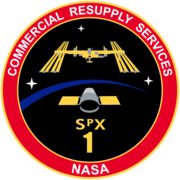SpaceX CRS-1

CRS-1 Dragon is seen approaching the ISS
|
|
| Mission type | ISS resupply |
|---|---|
| Operator | NASA |
| COSPAR ID | 2012-054A |
| SATCAT no. | 38846 |
| Spacecraft properties | |
| Spacecraft type | Dragon |
| Manufacturer | SpaceX |
| Start of mission | |
| Launch date | 8 October 2012, 00:34:07 UTC |
| Rocket | Falcon 9 v1.0 |
| Launch site | Cape Canaveral SLC-40 |
| Contractor | SpaceX |
| End of mission | |
| Disposal | Recovered |
| Landing date | 28 October 2012, 19:22 UTC |
| Orbital parameters | |
| Reference system | Geocentric |
| Regime | Low Earth |
| Inclination | 51.6 degrees |
| Berthing at ISS | |
| Berthing port | Harmony nadir |
| RMS capture | 10 October 2012, 10:56 UTC |
| Berthing date | 10 October 2012, 13:03 UTC |
| Unberthing date | 28 October 2012, 11:19 UTC |
| RMS release | 28 October 2012, 13:29 UTC |
| Time berthed | 17 days 22 hours 16 minutes |
| Cargo | |
| Mass | 400 kilograms (880 lb) |
| Pressurised | 400 kilograms (880 lb) |
|
|
|
SpaceX CRS-1, also known as SpX-1, was the third flight for Space Exploration Technologies Corporation's (SpaceX) uncrewed Dragon cargo spacecraft, the fourth overall flight for the company's two-stage Falcon 9 launch vehicle, and the first SpaceX operational mission under their Commercial Resupply Services contract with NASA. The launch occurred on 7 October 2012 at 20:34 EDT (8 October 2012 at 00:34 UTC).
In May 2012, it was reported that the CRS-1 Falcon 9 had been transported to Cape Canaveral. The CRS-1 Dragon later arrived on 14 August 2012. On 31 August 2012, a wet dress rehearsal was completed for the CRS-1 Falcon 9, and on 29 September a static fire test was completed; both of these tests were completed without the Dragon capsule attached to the launch vehicle stack. The mission passed its Launch Readiness Review on 5 October 2012.
The launch occurred on 8 October 2012 (UTC) and successfully placed the Dragon spacecraft into the proper orbit for arriving at the International Space Station with cargo resupply several days later. During the launch, one of the nine engines suffered a sudden loss of pressure about 80 seconds into the flight, and an immediate early shutdown of that engine occurred; debris could be seen in the telescopic video of the night launch. The remaining eight engines fired for a longer period of time and the flight control software adjusted the trajectory to insert Dragon into a near flawless orbit.
Dates are listed in UTC.
The mission plan, as published by NASA before the mission, called for the Falcon 9 to reach supersonic speed at one minute, 10 seconds after liftoff, and pass through the area of maximum aerodynamic pressure, "max Q"—the point when mechanical stress on the rocket peaks due to a combination of the rocket's velocity and resistance created by the Earth's atmosphere—10 seconds later. The plan called for two of the first-stage engines to shut down to reduce the rocket's acceleration at approximately 2 minutes 30 seconds into the flight, when the Falcon 9 would nominally be 90 kilometers (56 miles) high and traveling at 10 times the speed of sound. The remaining engines were planned to cut off shortly after—an event known as main-engine cutoff (MECO). Five seconds after MECO, the first and second stages separate. Seven seconds later, the second stage's single Merlin vacuum engine was projected to ignite to begin a 6-minute, 14-second burn to put Dragon into low-Earth orbit. Forty seconds after second-stage ignition, Dragon's protective nose cone, which covers Dragon's berthing mechanism, was planned to be jettisoned. At the 9-minute, 14-second mark after launch, the second-stage engine was scheduled to cut off (SECO). Thirty-five seconds later, Dragon was planned to separate from Falcon 9's second stage and reach its preliminary orbit. Dragon would, per plan, then deploy its solar arrays and open its guidance and navigation control (GNC) bay door which holds the sensors necessary for rendezvous and Dragon's grapple fixture.
...
Wikipedia

